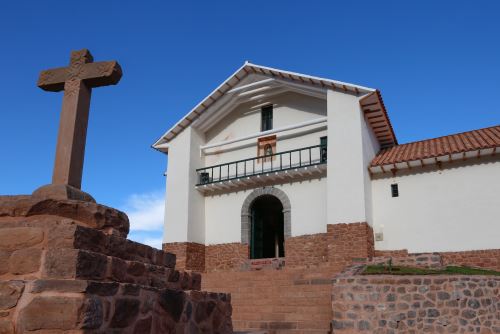, in partnership with Cusco's Decentralized Culture Directorate (DDC-Cusco), celebrated on June 19 the results of a 10-year collaboration to seismically retrofit and conserve the 17th-century Church of Kuñotambo as part of the GCI's Seismic Retrofitting Project (SRP).
The work could impact how the conservation of culturally and historically important earthen buildings is addressed across Latin America.
The church was unveiled and rededicated at an event at which residents of Kuñotambo celebrated project's completion.
"The work of the GCI and project partners at Kuñotambo is not only valuable to the community, but significantly advances ways we can protect earthen buildings around the world from the destructive effects of earthquakes," says
James Cuno, president and CEO of the J. Paul Getty Trust.
The Seismic Retrofitting Project began in 2009 as part of the GCI's Earthen Architecture Initiative, and grew out of many years of GCI research into the seismic strengthening of earthen buildings.
The objective of the SRP is to adapt high-tech retrofitting techniques to better match the equipment, materials, and technical skills available in many countries with earthen structures.
The first three phases of the project included identification and assessment of four prototype buildings in Peru representative of typologies across Latin America, as well as laboratory testing, in-situ testing, and numerical analyses of the four selected structures.
The project is now in its final phase, and includes the design and implementation of retrofitting and conservation measures at two of the prototype buildings —the Cathedral of Ica and the Church of Kuñotambo.

The Church of Kuñotambo is the most prominent building in the rural community of Kuñotambo, a remote agrarian village of 500 inhabitants in the Andes, located approximately 35 km south-east of the
city of Cusco.
It was built with thick mud brick walls and buttresses over a rubble stone masonry foundation and a wood-framed gable roof.
"This project is so meaningful not only because of the historical significance of the church, but because it is still actively used as a place of worship by the community," says Fredy Domingo Escobar Zamalloa, director of the
DDC-Cusco.
"The participation of the community in the work undertaken at the church was integral to the project," he said.
The structural performance of the building was severely compromised by a leaking roof, inadequate or broken connections of the roof framing, the loss of several exterior buttresses that weakened the walls, and settlement of the foundation that caused walls to lean and separate from the main structure.
Studies conducted by two universities and the GCI aimed to identify the properties of the building materials and construction systems in order to create accurate models of the building's behavior during an earthquake.
Based on the results of the modeling, a design for retrofitting was proposed which used local materials and techniques to stabilize and strengthen the structure.
In conjunction with this work, wall paintings conservators began an in-depth study and program of testing and stabilization to protect the site's wall paintings during construction.
"We are very pleased with the long-term collaboration with
the GCI and the results of the conservation project at Kuñotambo," says Culture Minister Ulla Holmquist.
The Implementation of seismic retrofitting and repair will begin this year on the Cathedral of ICA, the second of the SRP prototypes.
Editor's note: Photos provided by the J. Paul Getty Trust.
(END) NDP/RMB/MVB